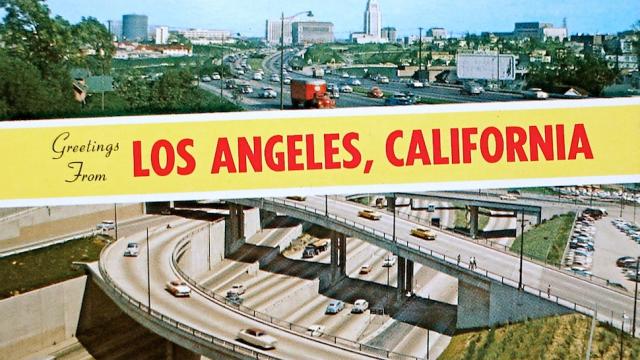I live in Los Angeles, a land of 20-lane interchanges, carparks the size of football stadiums, and mind-bending, soul-crushing, life-altering traffic. Every day, I meet people who don’t even know we have a public transit system and see places in my neighbourhood without any footpaths. This is because a half-century ago my city decided to redesign itself for cars, not humans.
LA’s seemingly brilliant plan to re-engineer its urban environment has become a global affliction. There are now 60 million new cars being added to the planet every year, and with those vehicles come more smog, toxic emissions and dependency on rapidly depleting resources. As we embrace the car, our cultures become more sedentary, and rates of obesity and heart disease increase. Cars not only make our cities unhealthy, they also make our cities dangerous: in some places, more people are killed by cars than infectious diseases like malaria.
To undo these decades of suburban propaganda is essentially to unravel a perversion of the American Dream, one that has since traveled around the world. But there is a new and better dream afoot, even right here in LA: one of a happier, healthier city engineered for walking.
Walking is the simplest, most cost-efficient way to improve a city’s economic and environmental viability. Walkable City author Jeff Speck said it best in his recent TEDCity2.0 talk: “Sustainability — which includes both health and wealth — may not be a function of our ecological footprint, but the two are deeply interrelated. If we pollute so much because we are throwing away our time, money, and lives on the highway, then both problems would seem to share a single solution, and that solution is to make our cities more walkable.”
I’ve found several inspiring examples of tools that can encourage citizens to choose walking, help designers build more inviting streets, and allow cities to prioritise people over cars.
Valuing walkability
You’ve likely heard of Walk Score, a tool that can tell you how walkable your address is by measuring its distance to amenities like restaurants, stores, and transit. Now Walk Score is gaining serious traction in the real estate market by promoting walkability as a desirable part of choosing where to live. The site recently began featuring apartment rentals with their Walk Scores prominently displayed, providing an interesting way to place actual value on what we pay in rent. I imagine hearing people at a dinner party a few years from now bragging about the great deal they got on a two-bedroom condo. Not only about the price: “It has a perfect 100 Walk Score!”
But it’s not just a feel-good tactic to rent apartments. A 2009 study by CEOs for Cities looked at 94,000 real estate transactions in 15 American markets and found that, in 13 of the 15 markets, higher walkability scores (using Walk Score’s rankings) were directly linked to higher home values. This is critical information for the people who are designing and building our neighbourhoods. Demonstrating that potential buyers value walkability will not only help developers focus their efforts building in walkable districts, but it can also help guide urban planners to encourage and incentivise new housing in these denser areas.
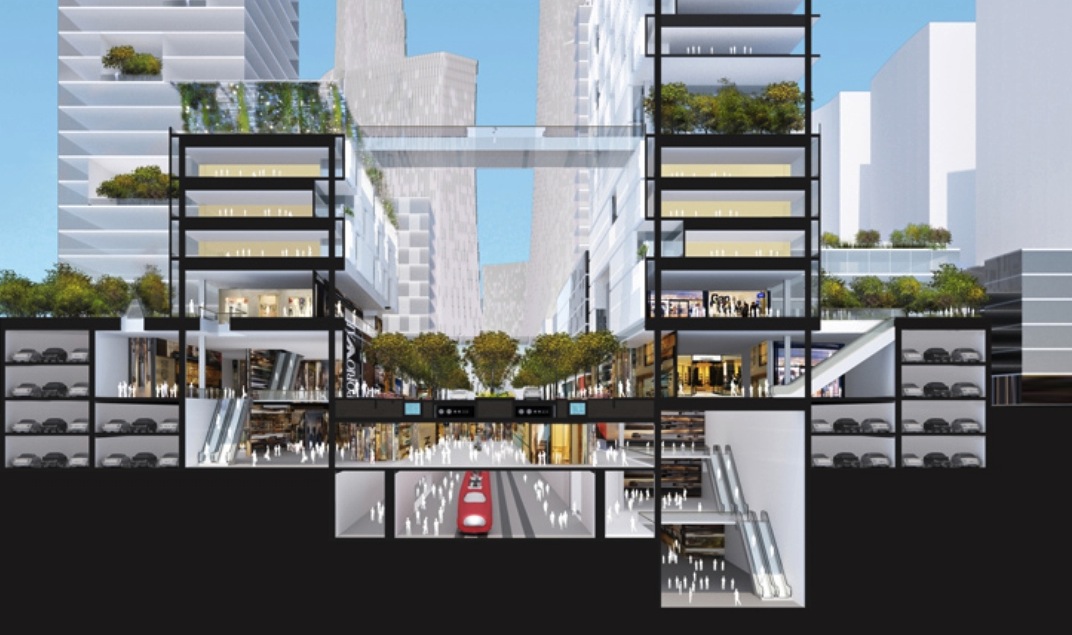
A cross-section of the Great City in Chengdu, China which will have a car-free center and many pedestrian-only zones
Car-free neighbourhoods are already a reality in places like Vauban, Germany, where the cars are banned and a tram to nearby Freiburg runs through the town. The Great City, planned for Chengdu, China, is even more ambitious, intended to house 80,000 people in a completely car-free centre with regional mass transit connections. Architects Adrian Smith and Gordon Gill estimate that residents will be able to walk anywhere in the city within 15 minutes.
Minutes, not miles
Knowing how long a walk will take makes all the difference. Walk Score features travel time maps, which allow you to see how far you’ll be able to walk, bike, drive or take public transport in a certain amount of time. Google Maps’ addition of walking, biking and transport options to its directions has been the greatest game-changer for increasing walking. With a click of a button, what was planned as a journey in a car becomes a possibility on foot.
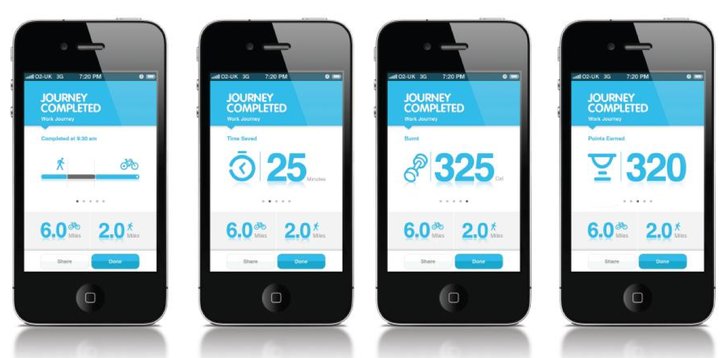
The Transport for London app Re:Route not only tells you how many calories you’ll burn by walking, it rewards you with points you can exchange for discounts at local businesses
Reroute.it allows you to compare your journey for several modes of transportation at once across many different factors: price, time, calories burned and the amount of CO2 emissions your trip will generate. Suddenly, a walk becomes more appealing when you can calculate its other benefits: even though it will take twice as long, for example, you’ll spend no money and could burn up to 500 calories. Even more fascinating is another app named Re:Route (above), which rewards Londoners who choose foot or bike transit with points that can be exchanged for discounts from a wide range of partners. That’s extra motivation to get walking.
This is only the beginning. With Google Glass and other augmented reality devices, the route information we receive on our smartphones will be displayed in the urban environment, in real time. This month, transit directions have been added to Glass, to complement the existing walking directions. Such information could be tacked onto our Nike FuelBands and FitBits, which would calculate how much walking we could add to our commute to achieve our daily step goal — maybe nudging us to get off the bus a stop early.
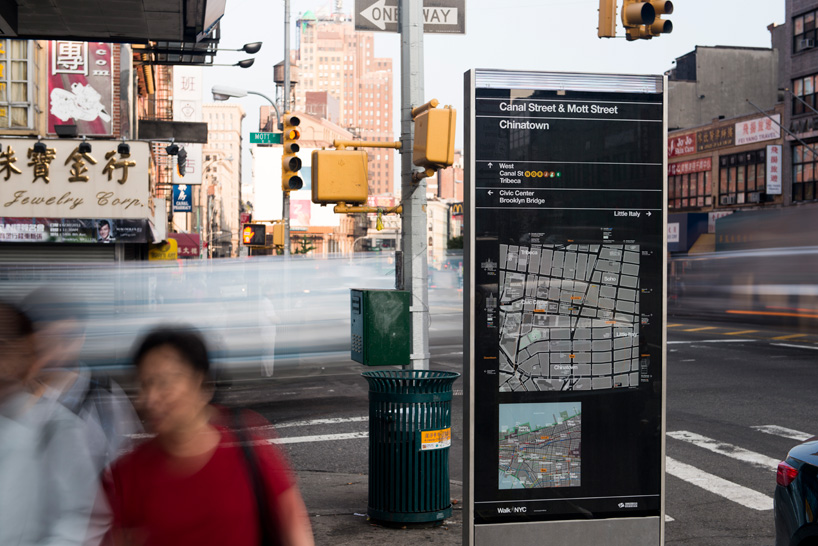
WalkNYC is a new wayfinding system designed by PentaCityGroup for New York City that helps walkers understand the distance between neighbourhoods and landmarks
But even with Google Glass at the ready to tell us our favourite bar is a 400-calorie walk away, we still need physical reminders our city is walkable. Intelligent signage can help. Legible London, a city-wide system, is one of the best examples out there, and New York City recently implemented WalkNYC.
For cities that don’t have the resources to create permanent signage, there’s the open-source project Walk Your City, which allows anyone to design, print and install wayfinding signage for their cities equipped with QR codes that can be scanned to see the entire system. Even though it’s a temporary solution, it can lead to real-world change: Signs installed in Raleigh, North Carolina, got the attention of the local transportation planners, and a movement was quickly underway to install city-approved signs.
The signs, in a sense, convert the invisible app data into a kind of value proposition for the walker. Landmarks are pointed out, of course, but the most powerful part of this signage is that it doesn’t express distances in miles — it measures in minutes. This is a small but important detail. If you tell someone a cafe is 3km miles away, it feels far. But if you say it’s a 30-minute walk, suddenly this starts to sound far more accessible.
Reclaiming the streets
You might physically be able to walk to a supermarket, but buckled pavements or poor street lighting might make the walk less than pleasant — meaning you may be less likely to do it again. A site called Walkonomics takes into consideration eight additional factors ranging from safety to beauty when ranking walkability. Instead of scoring an address, streets are ranked green, yellow and red based on how good they are for walking. Walkonomics uses data but there’s an effort to crowdsource these conditions using real-time human observations: A group called Walkability Asia has developed an app so anyone can gather information ranging from sidewalk quality to the speed of cars in 23 Asian cities.
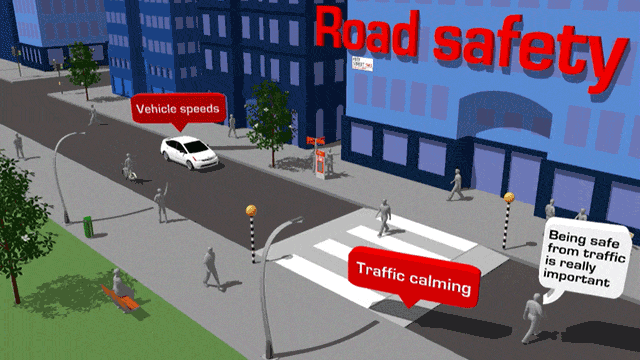
Walkonomics takes into account several different criteria when rating streets for their walkability
Perhaps the biggest deterrent for walkers is the perception that it’s unsafe, which can mean anything from dim street lighting to poorly marked crosswalks to high crime. In the near future, the proliferation of self-driving cars, like General Motors’ EN-V, could help prevent collisions with pedestrians (and other automobiles), and reduce the amount of urban space devoted to cars. But walking is the only option for a large percentage of the world’s population that cannot afford a car, which puts the planet’s most vulnerable citizens at risk — even by 2020, it’s estimated that 78 per cent of the households in China will still not have a car.
In emerging megacities such as Mumbai, narrow roads and paths designed for walking have now become overrun by vehicles. Some 40 per cent of people walk to work, and an astounding 57 per cent of all people killed in traffic accidents are pedestrians. In Chennai, a local newspaper launched a movement called Right to Walk which encouraged residents to photograph poor walking conditions in an effort to hold government leaders more responsible. It would appear that this advocacy is working: one of Chennai’s densest neighbourhoods is planning a pedestrian zone.
But another safety concern is our quickly ageing population, which can’t navigate the city as efficiently on foot. Transport planners are now redesigning cities for elderly walkers using a special suit developed by researchers at MIT called AGNES (Age Gain Now Empathy System) which mimics the speed, strength and dexterity of a person in their 70s. Using the suit, everything from crossing signals to curb heights can be adjusted.
Redesigning for accessibility, or universal design, will be perhaps the biggest changes we’ll begin to see in our cities in the upcoming years: ramps instead of stairs, larger type on signage, benches on more corners. In Thailand, the Chaing Mai province is investing in retirement communities, including making improvements to its urban space that will help make its cities more welcoming to pedestrians.
Inviting pedestrians
There has been perhaps no better advertisement for walking than the open-street festivals modelled after the ciclovías, common in Colombian cities. On Sundays, Bogota and Medellin close up to 130km of streets to cars. Cities have seen the value of turning tarmac over to walkers and bikers, if only for a few hours. Removing people from their cars creates a sense of social connectedness and allows citizens to interact with people from different backgrounds. It’s a win-win situation.

The open streets event CicLAvia in Los Angeles is the largest open streets event in the US. Photo by Gary Leonard
In Los Angeles, CicLAvia is held three times a year and has grown to become the largest open-street happenings in the U.S. with over 100,000 people in the streets per event. It goes against every known stereotype about LA.
But something interesting happened after the first few events: the city began to install permanent bike lanes and parklets along the routes where the festival happens. Walkers have now literally gained ground in the city — as they have around the world — with the addition of plazas and other car-free zones. Now, one of the city’s main thoroughfares, Broadway, is being converted into a pedestrian-friendly street.
The value of increased pedestrian activity goes beyond the good walking vibes: A recent study by UCLA noted that businesses that actively participated in CicLAvia saw their sales increase by 57 per cent, with customers more likely to return. Walking is now an economic driver for small businesses in city of Los Angeles. Not bad for a city that invented the freeway.
A version of this story was originally published as part of BBC Future’s Building Tomorrow series.
